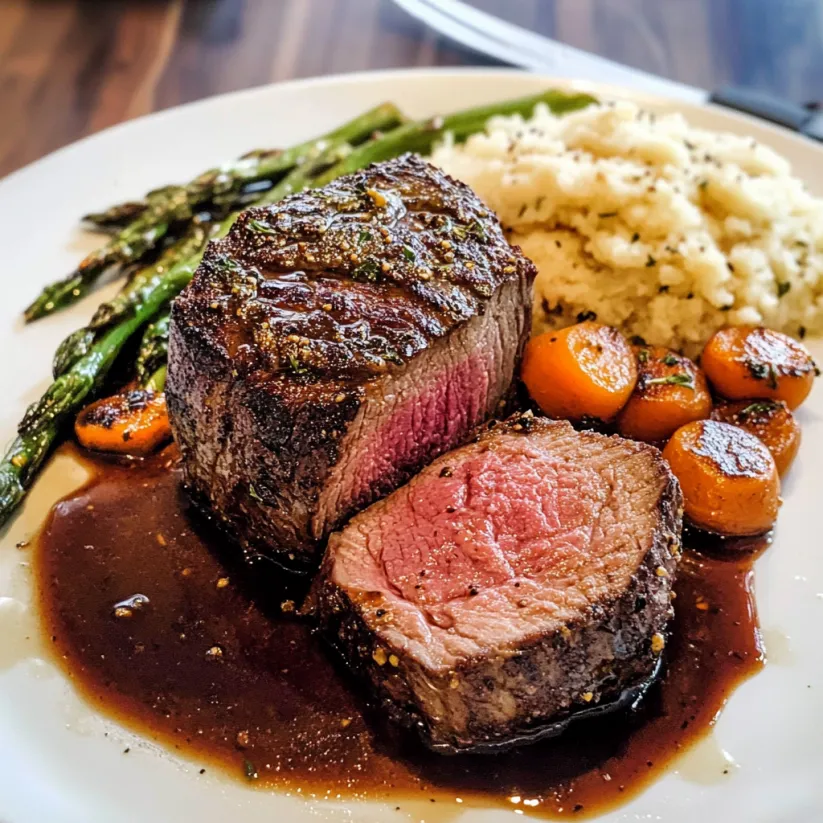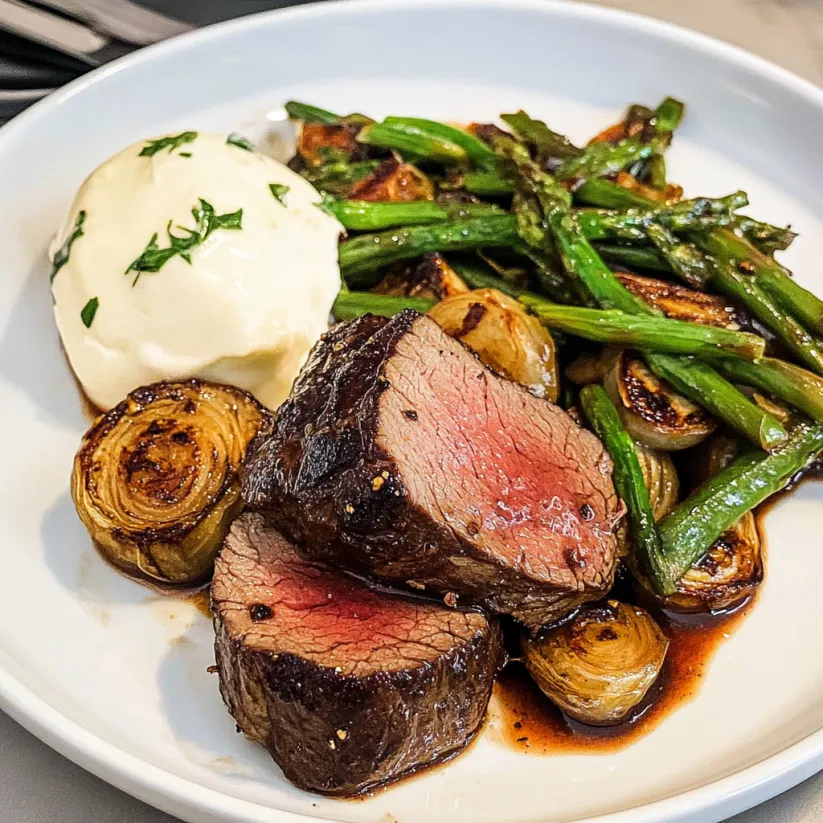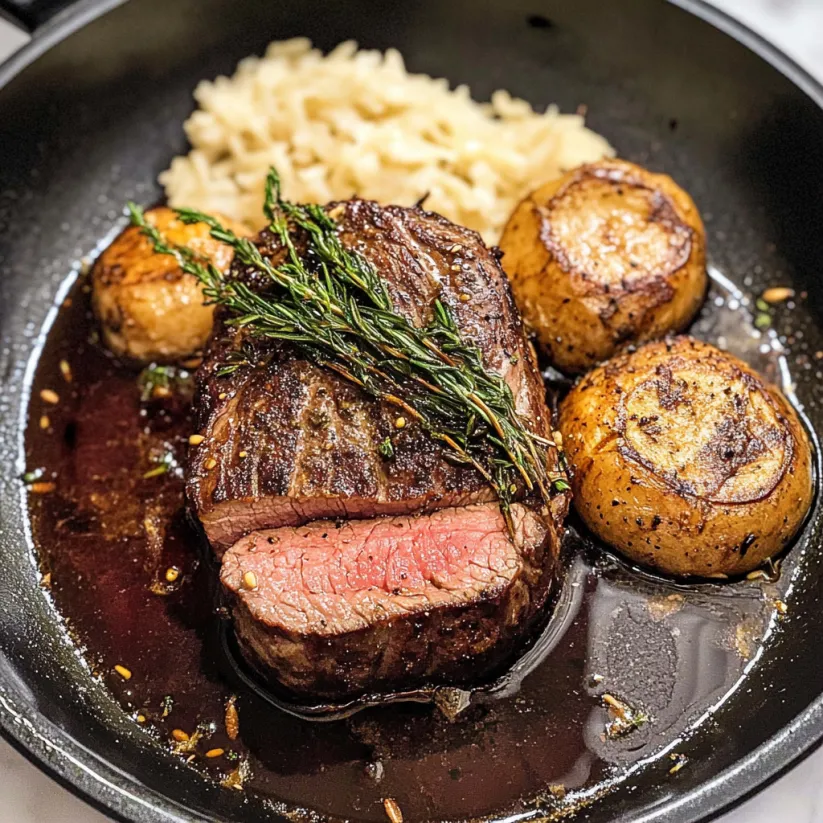 Save Pin
Save Pin
This whole roasted beef tenderloin transforms any dinner into a special celebration. The contrast between the caramelized exterior and juicy, perfectly pink center creates an unforgettable main course that always impresses guests while being surprisingly simple to prepare.
I first made this tenderloin for a Christmas dinner when I wanted something truly spectacular but didn't want to spend the entire day in the kitchen. The look on everyone's faces when I sliced into that perfectly rosy center convinced me this would become our holiday tradition.
Ingredients
- 3 pounds beef tenderloin quality matters tremendously here as this cut showcases pure beef flavor
- 1 teaspoon salt kosher salt works best for even seasoning
- 1 teaspoon pepper freshly cracked provides better flavor than pre-ground
- 1 tablespoon olive oil just enough to facilitate proper searing
- 3 tablespoons unsalted butter creates a beautifully rich exterior
- 2 tablespoons balsamic vinegar adds subtle sweetness and helps caramelize the exterior
- 1 teaspoon Dijon mustard acts as an emulsifier while adding depth
- 4 cloves garlic minced essential aromatic that penetrates the meat during roasting
- 3 springs thyme provides classic herb notes that complement beef perfectly
For Yogurt Sauce
- ½ cup Greek yogurt provides tangy base with thick creamy texture
- ¼ cup sour cream adds richness to balance the yogurt's tang
- 2 tablespoons lemon juice brightens the rich meat flavor
- 2 teaspoons horseradish adds pleasant heat that cuts through fattiness
- ¼ teaspoon salt enhances all flavors in the sauce
Step-by-Step Instructions
- Prepare the Tenderloin
- Trim silver skin from the tenderloin using a sharp knife. This tough connective tissue won't break down during cooking and must be removed. Tie the roast with kitchen twine at 1-inch intervals to create an even shape that cooks uniformly. Season generously all over with salt and pepper, pressing the seasonings gently into the meat.
- Create the Perfect Sear
- Heat olive oil in a large cast iron skillet until almost smoking. Carefully place the tenderloin in the hot pan and sear each section for 2-3 minutes without moving it, allowing a deep brown crust to form. Use tongs to rotate the roast until all sides are evenly seared. This critical step develops flavor through the Maillard reaction.
- Apply the Flavor Glaze
- Combine melted butter, balsamic vinegar, Dijon mustard, minced garlic and thyme in a small bowl, stirring until fully incorporated. Use a basting brush to thoroughly coat the entire tenderloin with this mixture, ensuring the aromatic flavors penetrate the meat during roasting.
- Master the Roast
- Transfer the skillet directly to a preheated 450°F oven. Roast for approximately 25 minutes for medium-rare, but rely on your meat thermometer rather than timing. Insert the thermometer into the thickest part of the meat, looking for 130°F for perfect medium-rare results. Remember the temperature will rise about 5 degrees during resting.
- Create the Complementary Sauce
- While the tenderloin roasts, whisk together Greek yogurt, sour cream, lemon juice, horseradish and salt in a small bowl until completely smooth. Refrigerate until serving time to allow flavors to meld. The cool, tangy sauce provides perfect contrast to the rich, warm beef.
- Rest and Serve
- Remove the tenderloin from the oven and transfer to a cutting board. Tent loosely with foil and allow to rest undisturbed for at least 10 minutes. This critical step allows juices to redistribute throughout the meat. Slice into medallions approximately ½-inch thick and serve with the yogurt sauce.
 Save Pin
Save Pin
The most transformative tip I ever received about beef tenderloin came from my grandfather who insisted on the importance of bringing the meat to room temperature before cooking. The first time I tried this technique, the difference was remarkable - the roast cooked more evenly and reached the perfect doneness without any guesswork.
Understanding Beef Tenderloin
Beef tenderloin comes from the loin section of the cow and represents one of the most tender cuts available because these muscles do very little work. This explains both its melt-in-your-mouth texture and higher price point. What makes tenderloin special is its leanness combined with exceptional tenderness. The tradeoff for this texture is slightly less intense flavor compared to fattier cuts like ribeye, which is precisely why we add the flavorful butter-balsamic glaze.
Perfecting Doneness Temperatures
The difference between perfectly cooked beef tenderloin and a disappointing result often comes down to just a few degrees. For rare tenderloin, remove from the oven at 120-125°F for a cool red center. Medium-rare requires 130-135°F resulting in a warm red center with optimal juiciness. If you prefer medium, aim for 140-145°F which yields a warm pink center. For well-done tenderloin, cook to 150°F, though this will sacrifice some tenderness. Always allow for carryover cooking during the resting period, when temperature typically rises 5 degrees.
Serving Suggestions
Beef tenderloin pairs beautifully with roasted potatoes that have been tossed with herbs and garlic before roasting until crispy. For vegetables, consider roasted asparagus, haricots verts, or a medley of colorful roasted vegetables that can cook while the tenderloin rests. The yogurt sauce provided works wonderfully, but you might also consider offering a red wine reduction or mushroom sauce for guests who prefer traditional accompaniments. For a truly special presentation, try serving each portion atop a small puddle of pureed potatoes or celery root.
Make-Ahead Options
You can prepare this tenderloin partially in advance to reduce day-of stress. Season and tie the tenderloin up to 24 hours before cooking, keeping it uncovered in the refrigerator to dry the surface for better searing. The yogurt sauce actually improves when made a day ahead as flavors have time to develop. You can even sear the tenderloin up to two hours before guests arrive, then finish it in the oven just before serving. The final roasting time may need slight adjustment if the meat has cooled significantly between steps.
 Save Pin
Save Pin
Commonly Asked Questions
- → How do I know when my beef tenderloin is cooked properly?
The only reliable way to ensure your beef tenderloin is cooked to perfection is by using a meat thermometer inserted into the thickest part. Temperature guidelines: 120-125°F for rare, 130-135°F for medium-rare, 140-145°F for medium, and 150°F for well-done. Medium-rare (130-135°F) is generally recommended to preserve the tenderloin's natural tenderness and flavor.
- → Should I tie my beef tenderloin before cooking?
Yes, tying your tenderloin with kitchen twine helps it maintain a uniform shape during cooking, which ensures even heat distribution. This step is especially important if your tenderloin has an uneven thickness or a tapered end. Properly tied tenderloin will cook more evenly and create a more attractive presentation when sliced.
- → Why do I need to let the beef tenderloin rest after cooking?
Resting the beef tenderloin for about 10 minutes under foil allows the juices to redistribute throughout the meat. If you slice it immediately after removing from the oven, those flavorful juices will run out onto your cutting board instead of remaining in the meat. Resting ensures a juicier, more flavorful final result.
- → Can I prepare any components of this dish ahead of time?
Yes! The yogurt horseradish sauce can be prepared up to 24 hours ahead and stored in the refrigerator. You can also trim and tie the tenderloin, and even prepare the balsamic-garlic glaze in advance. Store everything separately in the refrigerator. Just remember to bring the tenderloin to room temperature for about 30 minutes before cooking for the most even results.
- → What's the best way to store and reheat leftover beef tenderloin?
Store leftover beef tenderloin in an airtight container in the refrigerator for 3-4 days. For longer storage, wrap portions tightly and freeze for up to 3 months. To reheat without overcooking, place slices in a baking dish with a splash of beef broth, cover with foil, and warm in a 300°F oven just until heated through. Alternatively, enjoy it cold on sandwiches!
- → What can I serve with beef tenderloin?
Beef tenderloin pairs beautifully with roasted potatoes, creamy mashed potatoes, or grilled vegetables. For a complete meal, consider serving with roasted asparagus, a simple green salad, or sautéed mushrooms. The tenderloin's rich flavor also complements bold red wines like Cabernet Sauvignon or Merlot for a truly special dining experience.
